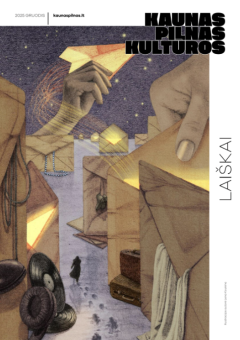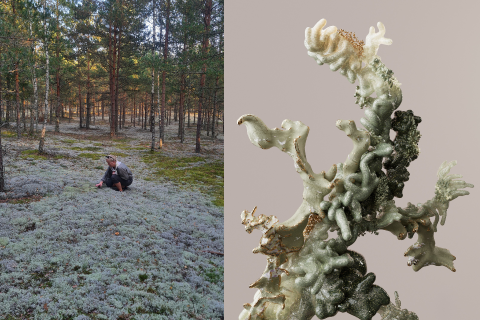The heroine of this article, who grew up in Kaunas and emigrated to England involuntarily at the age of 17, said hi to me while she was in Italy. This stop is temporary, Marijam Didžgalvytė is building a life in Copenhagen, but she briefly swapped houses with a friend. In February, Marijam will be in her hometown Kaunas, where she will present her debut book, translated into Lithuanian by Tomas Marcinkevičius-Baronas and published by Lapas.

Everything to Play For: How Videogames Are Changing the World was published last year in the English-speaking world with the support of Verso Books, an indie publishing house with a very progressive approach.
Between screen and activism
Marijam’s path meanders from the streets of Kaunas city center and the Art Gymnasium to international art and activism spaces. In her practice, she combines culture, politics, and personal experience into a seamless, often provocative narrative. When asked to recall her first experience with video games, she reveals that in childhood, they were a way to connect with family members she wasn’t close to, “In the book, I tell the story of a video game parlor in a yellow wooden house on Miško Street, where children of a similar fate would gather – kids for whom the beginning of the new century was anything but sweet. Back then, Kaunas city center wasn’t all polished with EU-funded paint and paved with neat tiles like it is now.”
In 2008, when the financial crisis hit, Marijam and her mother became economic migrants. “Although my parents were theater critics by education, it was difficult to sustain a career in the cultural field at the time. Emigration was the only way out.” This meant saying goodbye to her beloved friends and the city she still speaks of with great warmth. One of her favorite childhood places was the Tadas Ivanauskas Zoological Museum in Kaunas, which, to her delight, has remained almost unchanged to this day.
Marijam spent over a dozen years in London studying at prestigious art institutions – Central Saint Martins and Goldsmiths College – while becoming involved in the local activist scene. She secretly continued to enjoy video games, aware of their potential as a cultural and political space. “Back in Kaunas, I was involved in activism, we had our own infoshop,” she recalls of her teenage years. And why did she play in secret while in London? “In my circles – especially among leftists, anarchists, and artists – it was seen as something very trivial.”
Culture, politics and social change
Marijam’s perception of videogames as a cultural and political force, not just entertainment, has been shaped by watching their growing influence. It became clear to her that the industry, while surpassing the worlds of cinema and music by billions, was simply being ignored as a cultural and political space. This led her to delve into the intersections between games and politics, write her master’s thesis, create a critical blog and eventually publish a book.
This is the main message of the book: video games are not just entertainment; they also represent a multifaceted cultural space where social, political, and economic processes are expressed. The author argues that video games hold significant potential for social change but simultaneously serve as tools for radicalization and manipulation. According to Marijam, the video game industry, dominated by a few large corporations, faces numerous ethical issues related to worker exploitation and environmental consequences. For instance, PlayStation 4 consoles consume the same amount of electricity each year as the entire nation of Estonia. Additionally, there are conflict minerals present in these devices!
There is room for improvement
Marijam’s book explores several key ideas. First, video games, as one of the largest cultural industries, serve as an important political space where opinions, identities, and social movements take shape. Thus, it is crucial to recognize the potential for radicalization and manipulation within this medium.
She is also interested in how culture, including video games, can be used to bring about social change. That is, games can be not just an aesthetic form of artistic expression, but also a tool for social critique.
We also discuss the intersections between contemporary art and the world of video games – in this very issue, painter Mantas Valentukonis talks about how he programs his own game environment. According to Marijam, it is only natural for artists to use the medium of video games, but they also have to be responsible for the tools they use and their consequences.
To say, “I am gaming” is to say nothing. From Solitaire, which the middle generation grew up with (because they often had no internet), to the latest GTA, which generated a billion in pre-orders alone, the world of games is wide, but not wide enough. “There are games that are closer to art and social criticism and those that serve entertainment and commercial purposes. It is therefore important to be critical not only of games but also of how they are created and distributed,” Marijam says. Her book is full of personal experience, which helps readers understand how video games relate to identity, social issues, and visions of the future.
Lithuanian translation
The book by a Lithuanian who has lived abroad for more than 16 years was originally written in English, “It will be clear to those who read the original version that it is not written by a native English speaker – I think that’s the charm of it.” The author is pleased that she was able to retain the rights to the Lithuanian edition during negotiations with Verso Books. At the same time, she notes that the language rules in Lithuania are stricter, “I understand that there are standards, that editors and translators need the text to be perfect, but I don’t speak like that, and it’s not my fault, it’s a consequence of the Lithuanian politics of failing to protect its people and forcing them to emigrate.”
According to the Kaunas resident, the Lithuanian edition of the book, is necessary to broaden our discourse on video games. So far, a narrow view prevails in Lithuania, mostly limited to criticism of video games as a source of addiction or praise for the successful industry. Meanwhile, the diversity of video games presented by Marijam and their impact on society is also an invitation to discussion. “Of course, we should enjoy quality products, which are increasing in Lithuania too, but my aim is not to promote the industry – at least not until it tries to wash its sins away.”
The book was launched at the British Library in London, was listed as one of the best books of 2024 by The Guardian, and received glowing reviews from Publishers Weekly, ArtReview and many other media outlets and independent critics. The book is already being translated into 7 languages!
Kaunas residents should mark February 22 on their calendars. That evening Marijam Didžgalvytė plans to present the book Everything to Play For: How Videogames Are Changing the World in Godo bar. Lapas Publishing House will definitely have the new book at its stand at the Vilnius Book Fair.




